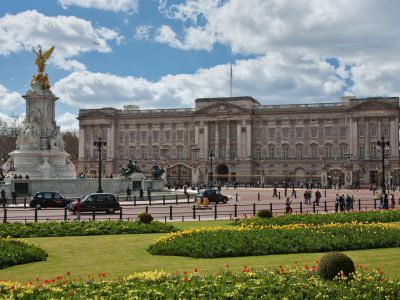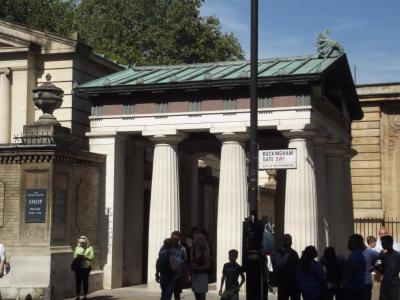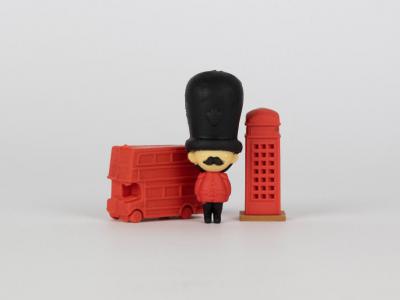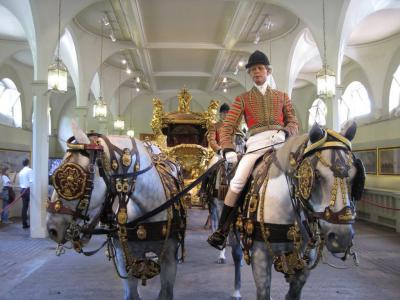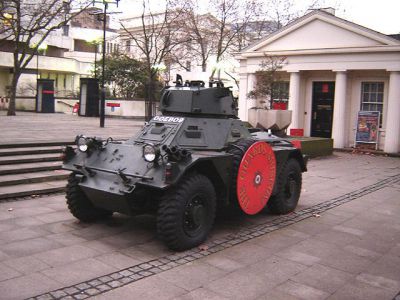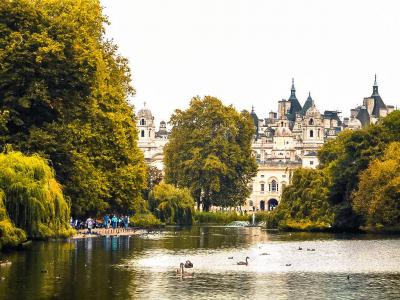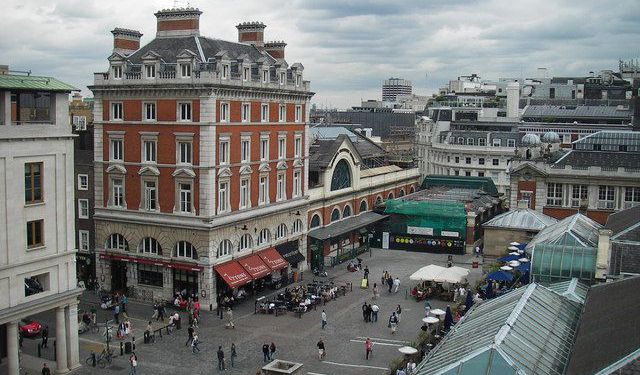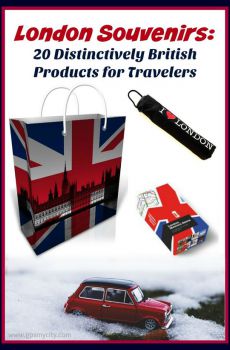Walk around Buckingham Palace (Self Guided), London
Buckingham Palace, the British monarch's official residence, is a must-see for anyone visiting London, but so are the adjacent royal establishments that give a unique window into the royal way of life. On this self-guided walking tour, along with Buckingham Palace and its memorable fountain, you will visit the St. James's private royal residence, the wonderful Queen's Gallery, and also drop by the official Buckingham gift shop to find a piece of royal memory to bring home.
Other highlights include the Royal Mews where, aside for the horses not on duty, you can get up close and personal with the Royal carriages, cars, and even a sleigh. Besides being an informative “behind-the-scenes” glimpse at what it takes to execute the pomp and circumstance, it kind of feels like you’ve been dropped into a fairy tale!
From there you can walk into the Guards Museum and stop off at St. James’s Park for a sit and picnic as well, making the most of being outdoors. And, finally, next to St. James’s Palace, you’ll be able to spot Clarence House, home to Prince Charles and the Duchess of Cornwall. Oozing class, it’s one of the last remaining aristocratic houses in London – a must for all London visitors.
For an excellent day out around Buckingham Palace, follow this self-guided walking tour – perfect for individuals, couples and families alike.
Other highlights include the Royal Mews where, aside for the horses not on duty, you can get up close and personal with the Royal carriages, cars, and even a sleigh. Besides being an informative “behind-the-scenes” glimpse at what it takes to execute the pomp and circumstance, it kind of feels like you’ve been dropped into a fairy tale!
From there you can walk into the Guards Museum and stop off at St. James’s Park for a sit and picnic as well, making the most of being outdoors. And, finally, next to St. James’s Palace, you’ll be able to spot Clarence House, home to Prince Charles and the Duchess of Cornwall. Oozing class, it’s one of the last remaining aristocratic houses in London – a must for all London visitors.
For an excellent day out around Buckingham Palace, follow this self-guided walking tour – perfect for individuals, couples and families alike.
How it works: Download the app "GPSmyCity: Walks in 1K+ Cities" from Apple App Store or Google Play Store to your mobile phone or tablet. The app turns your mobile device into a personal tour guide and its built-in GPS navigation functions guide you from one tour stop to next. The app works offline, so no data plan is needed when traveling abroad.
Walk around Buckingham Palace Map
Guide Name: Walk around Buckingham Palace
Guide Location: England » London (See other walking tours in London)
Guide Type: Self-guided Walking Tour (Sightseeing)
# of Attractions: 8
Tour Duration: 1 Hour(s)
Travel Distance: 2.3 Km or 1.4 Miles
Author: DanaOffice
Sight(s) Featured in This Guide:
Guide Location: England » London (See other walking tours in London)
Guide Type: Self-guided Walking Tour (Sightseeing)
# of Attractions: 8
Tour Duration: 1 Hour(s)
Travel Distance: 2.3 Km or 1.4 Miles
Author: DanaOffice
Sight(s) Featured in This Guide:
- Buckingham Palace
- Queen's Gallery
- Buckingham Palace Gift Shop
- Royal Mews
- Wellington Barracks & The Guards Museum
- St. James's Park
- St. James's Palace
- Clarence House
1) Buckingham Palace (must see)
The postcard-perfect face of the British monarchy, Buckingham Palace is possibly the world’s fanciest “office.” What began in 1703 as a cozy townhouse for the Duke of Buckingham (hence the name) ended up becoming royal property in 1761 when King George III bought it for his wife, Queen Charlotte. By 1837, Queen Victoria had officially moved in, setting up camp and turning it into the headquarters of royal business and the heart of Britain's ceremonial life ever since.
Today, the palace packs a whopping 775 rooms, including 52 royal and guest bedrooms, 78 bathrooms (because clearly, you never know when you’ll need a backup loo), and countless other rooms fit for everything from crown-polishing to state banquets. While most of these royal spaces are strictly off-limits, commoners-like us, the curious public-can sneak a peek during special visiting seasons, mainly August and September, plus select days in winter and spring.
Step inside the palace’s 19 State Rooms and prepare to have your jaw royally dropped. Here, we’re talking chandeliers that could double as UFOs, lavish gold trim, and masterpieces by Rembrandt and Rubens just casually hanging around. You’ll stroll through the Throne Room (cue the imaginary fanfare), the Ballroom where knighthoods are handed out like royal gold stars, the Grand Staircase, and a variety of drawing rooms, each with its own personality-from the Blue Drawing Room’s stately charm to the Music Room’s lapis columns and the gleaming White Drawing Room. Don’t skip the State Dining Room either-this is where the portraits watch you more than you watch them.
Outside, the Changing of the Guard steals the show with its precision marching, bearskin hats, and musical flair. It’s essentially a military ballet, free of charge-but do arrive early for the best view, as everyone and their selfie stick wants in.
Right next door, the Queen’s Gallery serves up rotating exhibits from the Royal Collection, including priceless paintings, sparkling jewels, and historic treasures galore. A few steps away, the Royal Mews stables show off the royal horses and carriages, because royalty of all people needs a stylish ride.
Tip:
Snag a timed-entry ticket (they’re released in 15-minute waves), and if you’ve got time, tack on a garden tour for some fresh air and manicured perfection. Give yourself two hours-minimum-because once you step into Buckingham Palace, you’ll want to soak up every royal second.
Today, the palace packs a whopping 775 rooms, including 52 royal and guest bedrooms, 78 bathrooms (because clearly, you never know when you’ll need a backup loo), and countless other rooms fit for everything from crown-polishing to state banquets. While most of these royal spaces are strictly off-limits, commoners-like us, the curious public-can sneak a peek during special visiting seasons, mainly August and September, plus select days in winter and spring.
Step inside the palace’s 19 State Rooms and prepare to have your jaw royally dropped. Here, we’re talking chandeliers that could double as UFOs, lavish gold trim, and masterpieces by Rembrandt and Rubens just casually hanging around. You’ll stroll through the Throne Room (cue the imaginary fanfare), the Ballroom where knighthoods are handed out like royal gold stars, the Grand Staircase, and a variety of drawing rooms, each with its own personality-from the Blue Drawing Room’s stately charm to the Music Room’s lapis columns and the gleaming White Drawing Room. Don’t skip the State Dining Room either-this is where the portraits watch you more than you watch them.
Outside, the Changing of the Guard steals the show with its precision marching, bearskin hats, and musical flair. It’s essentially a military ballet, free of charge-but do arrive early for the best view, as everyone and their selfie stick wants in.
Right next door, the Queen’s Gallery serves up rotating exhibits from the Royal Collection, including priceless paintings, sparkling jewels, and historic treasures galore. A few steps away, the Royal Mews stables show off the royal horses and carriages, because royalty of all people needs a stylish ride.
Tip:
Snag a timed-entry ticket (they’re released in 15-minute waves), and if you’ve got time, tack on a garden tour for some fresh air and manicured perfection. Give yourself two hours-minimum-because once you step into Buckingham Palace, you’ll want to soak up every royal second.
2) Queen's Gallery
In today's London, it's almost a rite of passage for every visitor to make their way to Buckingham Palace to witness the renowned Changing of the Guard ceremony. However, what many may not realize is that the palace also boasts a remarkable cultural attraction of its own – the Queen's Gallery. Interestingly, it's worth noting that at one point in history, Buckingham House, which once occupied the same location as the palace does today, was considered a possible location for the British Museum. Ultimately, this idea was abandoned due to cost considerations.
Originally a private chapel, this space was repurposed after World War II, following bomb damage, and officially reopened as a gallery in 1962. Today, it’s part of the Royal Collection Trust and holds rotating exhibitions that draw from one of the largest and most prestigious art collections in the world.
The gallery features works by legendary artists like Michelangelo, Raphael, Rembrandt, Vermeer, Van Dyck, and Rubens, among many others. It houses the world’s largest group of Leonardo da Vinci’s drawings, as well as impressive displays of Fabergé eggs, Sèvres porcelain, royal jewelry, ceremonial weaponry, and textiles. The venue spans just seven rooms, making it an ideal visit for those looking to experience culture without spending an entire day in a museum.
Visitors may be surprised to learn that this royal gallery’s collection is actually three times larger than that of the National Gallery. And because exhibitions change regularly, you’re guaranteed a fresh experience each time you go-one season may spotlight Renaissance art, while another focuses on royal fashion or historic photography. The gallery is curated to feel intimate but rich in content, combining regal elegance with public accessibility.
For tourists, it’s an easy addition to a day exploring Buckingham Palace or St. James’s Park, especially if you’re already planning to catch the Changing of the Guard. A visit can be topped off with a stop at the on-site gift shop, which offers tasteful royal-themed souvenirs. Just be aware: photography and phone use are not allowed inside the gallery.
In short, the Queen’s Gallery is a hidden gem: a stylish dive into centuries of royal taste, curated with velvet ropes and a dash of royal flair.
Tip:
Get your ticket stamped before leaving, and you’ll be able to return for free within the next 12 months to see future exhibitions.
Originally a private chapel, this space was repurposed after World War II, following bomb damage, and officially reopened as a gallery in 1962. Today, it’s part of the Royal Collection Trust and holds rotating exhibitions that draw from one of the largest and most prestigious art collections in the world.
The gallery features works by legendary artists like Michelangelo, Raphael, Rembrandt, Vermeer, Van Dyck, and Rubens, among many others. It houses the world’s largest group of Leonardo da Vinci’s drawings, as well as impressive displays of Fabergé eggs, Sèvres porcelain, royal jewelry, ceremonial weaponry, and textiles. The venue spans just seven rooms, making it an ideal visit for those looking to experience culture without spending an entire day in a museum.
Visitors may be surprised to learn that this royal gallery’s collection is actually three times larger than that of the National Gallery. And because exhibitions change regularly, you’re guaranteed a fresh experience each time you go-one season may spotlight Renaissance art, while another focuses on royal fashion or historic photography. The gallery is curated to feel intimate but rich in content, combining regal elegance with public accessibility.
For tourists, it’s an easy addition to a day exploring Buckingham Palace or St. James’s Park, especially if you’re already planning to catch the Changing of the Guard. A visit can be topped off with a stop at the on-site gift shop, which offers tasteful royal-themed souvenirs. Just be aware: photography and phone use are not allowed inside the gallery.
In short, the Queen’s Gallery is a hidden gem: a stylish dive into centuries of royal taste, curated with velvet ropes and a dash of royal flair.
Tip:
Get your ticket stamped before leaving, and you’ll be able to return for free within the next 12 months to see future exhibitions.
3) Buckingham Palace Gift Shop
Just a short distance from the Royal residence, this gift store offers official royal merchandise, making it a must-visit for those with a penchant for all things regal during their London trip. You'll find a wide array of high-quality products, including porcelain and textiles, offering visitors a close-to-authentic experience of living like royalty.
Among the items, you'll also discover the former Queen's preferred chocolate, royal shower caps, regal hand cream, and numerous other items used by the British royal family. Notably, the shop prominently features the Queen's beloved Corgis, her favorite dog breed. The staff is exceptionally welcoming and helpful, providing clear guidance and recommendations.
Among the items, you'll also discover the former Queen's preferred chocolate, royal shower caps, regal hand cream, and numerous other items used by the British royal family. Notably, the shop prominently features the Queen's beloved Corgis, her favorite dog breed. The staff is exceptionally welcoming and helpful, providing clear guidance and recommendations.
4) Royal Mews
Explore an opulent display of royalty by paying a visit to the Royal Mews. Designed by John Nash in 1825, the stables and coach houses house the royal family's state carriages, along with their distinctive horses, ridden by postilions wearing red-and-gold attire and wigs. For families with children, there are activities to enjoy, and from April to October, complimentary guided tours are offered.
The Mews boasts a vast assortment of coaches, motorcars, and carriages, including Queen Victoria's Irish state coach, acquired for the State Opening of Parliament; the 1902 royal landau, an open-top carriage used to provide the public with a prime view of newlywed royal couples; and the glass coach, also employed in royal weddings. The most recent addition is the 2012 Diamond Jubilee State Coach, an elegant black-and-gold creation featuring a concealed camera for filming during processions.
The collection's crowning jewel is the Gold State Coach, a mobile masterpiece created for George III in 1762. Adorned with 22-carat gilding and embellished with panel paintings by Cipriani, this four-tonne behemoth is supported by axles featuring four life-sized Tritons blowing conches. Eight horses are required to pull it, and the experience reportedly left Queen Victoria feeling quite queasy; as a result, it has only been used for coronations and jubilees since.
The Mews boasts a vast assortment of coaches, motorcars, and carriages, including Queen Victoria's Irish state coach, acquired for the State Opening of Parliament; the 1902 royal landau, an open-top carriage used to provide the public with a prime view of newlywed royal couples; and the glass coach, also employed in royal weddings. The most recent addition is the 2012 Diamond Jubilee State Coach, an elegant black-and-gold creation featuring a concealed camera for filming during processions.
The collection's crowning jewel is the Gold State Coach, a mobile masterpiece created for George III in 1762. Adorned with 22-carat gilding and embellished with panel paintings by Cipriani, this four-tonne behemoth is supported by axles featuring four life-sized Tritons blowing conches. Eight horses are required to pull it, and the experience reportedly left Queen Victoria feeling quite queasy; as a result, it has only been used for coronations and jubilees since.
5) Wellington Barracks & The Guards Museum
Accessed via Birdcage Walk, a name originating from James I's former aviary on this site, this museum resides beneath the parade ground of Wellington Barracks, which covers more than half of its expanse. Constructed in 1833, this barracks functions as the central command center for the five Foot Guards regiments and showcases a Neoclassical frontage.
The museum itself showcases the resplendent scarlet-and-blue uniforms donned by these five regiments of the Foot Guards during ceremonial duties and provides insights into their intricate histories. Additionally, it offers a concise overview of the nation's military history from the English Civil War (1642–51) onwards. Among the exhibits, you'll find a diverse array of war spoils, ranging from Dervish prayer mats looted from Sudan in 1898 to items seized from an Iraqi prisoner of war during the first Gulf War. The collection even includes articles worn by the former Queen Elizabeth II, as she held the formal position of commanding these regiments.
The museum itself showcases the resplendent scarlet-and-blue uniforms donned by these five regiments of the Foot Guards during ceremonial duties and provides insights into their intricate histories. Additionally, it offers a concise overview of the nation's military history from the English Civil War (1642–51) onwards. Among the exhibits, you'll find a diverse array of war spoils, ranging from Dervish prayer mats looted from Sudan in 1898 to items seized from an Iraqi prisoner of war during the first Gulf War. The collection even includes articles worn by the former Queen Elizabeth II, as she held the formal position of commanding these regiments.
6) St. James's Park (must see)
Once upon a royal time, a queen casually asked her courtier how much it would cost to kick the public out of St. James’s Park. The courtier, with nerves of steel and a flair for drama, replied, “Only your crown, ma’am.” And that pretty much sums up the importance of this place-mess with the people’s park, and you’re one coronation short of a monarchy.
Wedged gracefully between three heavy-hitters-Buckingham Palace, St. James’s Palace, and the political power zone of Westminster-St. James’s Park is London’s oldest and arguably most charming green retreat. Back in 1532, Henry VIII thought this marsh was in great need of deer, so he snapped it up for his very own deer nursery. Later, during the reign of James I, the land was drained, and an aviary was installed (giving rise to the name Birdcage Walk), along with a zoo that featured exotic species like crocodiles, camels, and even an elephant.
Then came Charles II, freshly returned from exile in France with some serious garden envy after ogling Versailles. He rolled up his sleeves and transformed the park into a regal playground with neat avenues, fruit trees, a canal, and a whole zoo of goats, sheep, and deer casually grazing the lawns. By the 1700s, the park had taken a turn for the scandalous, becoming a preferred hunting ground for the affluent individuals seeking... nighttime companions.
In the 19th century, the romantic stylings of John Nash (one of the foremost British architects of the Georgian and Regency eras) gave the park its current look-a picturesque escape with winding paths and dreamy views. Peer down the lake toward Buckingham Palace, and you can easily imagine having wandered onto a countryside estate-until a pelican flaps by.
Speaking of birds, Duck Island at the lake’s eastern tip is a feathery haven for pelicans, swans (King-owned, naturally), geese, and ducks. From March to October, deck chairs appear like sun-seeking mushrooms-perfect for office lunch breaks or tuning into a bandstand performance at midday.
Evenings are a delight here too, as the lake reflects the glowing silhouettes of Westminster Abbey and the Parliament buildings. It’s part fairy tale, part postcard, and entirely worth a visit. Lush lawns, birds with better titles than you, and the occasional live performance. Basically, it’s where London goes to exhale...
Wedged gracefully between three heavy-hitters-Buckingham Palace, St. James’s Palace, and the political power zone of Westminster-St. James’s Park is London’s oldest and arguably most charming green retreat. Back in 1532, Henry VIII thought this marsh was in great need of deer, so he snapped it up for his very own deer nursery. Later, during the reign of James I, the land was drained, and an aviary was installed (giving rise to the name Birdcage Walk), along with a zoo that featured exotic species like crocodiles, camels, and even an elephant.
Then came Charles II, freshly returned from exile in France with some serious garden envy after ogling Versailles. He rolled up his sleeves and transformed the park into a regal playground with neat avenues, fruit trees, a canal, and a whole zoo of goats, sheep, and deer casually grazing the lawns. By the 1700s, the park had taken a turn for the scandalous, becoming a preferred hunting ground for the affluent individuals seeking... nighttime companions.
In the 19th century, the romantic stylings of John Nash (one of the foremost British architects of the Georgian and Regency eras) gave the park its current look-a picturesque escape with winding paths and dreamy views. Peer down the lake toward Buckingham Palace, and you can easily imagine having wandered onto a countryside estate-until a pelican flaps by.
Speaking of birds, Duck Island at the lake’s eastern tip is a feathery haven for pelicans, swans (King-owned, naturally), geese, and ducks. From March to October, deck chairs appear like sun-seeking mushrooms-perfect for office lunch breaks or tuning into a bandstand performance at midday.
Evenings are a delight here too, as the lake reflects the glowing silhouettes of Westminster Abbey and the Parliament buildings. It’s part fairy tale, part postcard, and entirely worth a visit. Lush lawns, birds with better titles than you, and the occasional live performance. Basically, it’s where London goes to exhale...
7) St. James's Palace
Constructed in the 1530s by Henry VIII, who also laid out the hunting grounds that eventually became Saint James's Park, Saint James's Palace marked the first royal dwelling on this particular parcel of land, located to the south of Piccadilly and to the north of The Mall. Following the devastating fire that engulfed Whitehall Palace in 1698, all of London's attention shifted to this palace, which assumed the role of the new royal residence. Throughout the 18th and 19th centuries, the surrounding area grew into a prestigious residential district, leading to the disappearance of older estates as mansions sprouted and streets were carefully planned for the aristocracy.
In 1952, Queen Elizabeth II delivered her first address as monarch from this historic location, and foreign ambassadors continue to hold official accreditation to the Court of Saint James's. While the palace houses various royal chambers and administrative offices, it remains off-limits to the general public. Nevertheless, the unassuming Tudor facade is worth a brief detour from The Mall, and the Friary Court in front provides an impressive backdrop for Trooping the Colour, a component of the Queen's official birthday festivities.
Visitors often seize the opportunity to capture a photo of the guardsman in scarlet attire standing watch outside the imposing Tudor gateway. It's worth noting that the Changing the Guard ceremony at this location occurs solely on days when there is a changing of the guard at Buckingham Palace.
In 1952, Queen Elizabeth II delivered her first address as monarch from this historic location, and foreign ambassadors continue to hold official accreditation to the Court of Saint James's. While the palace houses various royal chambers and administrative offices, it remains off-limits to the general public. Nevertheless, the unassuming Tudor facade is worth a brief detour from The Mall, and the Friary Court in front provides an impressive backdrop for Trooping the Colour, a component of the Queen's official birthday festivities.
Visitors often seize the opportunity to capture a photo of the guardsman in scarlet attire standing watch outside the imposing Tudor gateway. It's worth noting that the Changing the Guard ceremony at this location occurs solely on days when there is a changing of the guard at Buckingham Palace.
8) Clarence House
Clarence House, which served as the Queen Mother's London residence for nearly five decades until her passing in 2002, is now the home of Charles, the Prince of Wales, and his spouse, Camilla, the Duchess of Cornwall. This Regency mansion, constructed in 1828 by architect John Nash for the Duke of Clarence (who later became King William IV), was built because the Duke found the nearby Saint James's Palace too cramped for his tastes. However, post-World War II renovations have resulted in little of Nash's original design remaining.
If you wish to visit Clarence House, you must book a guided tour in advance (as they are in high demand), and be prepared for security checks and restrictions similar to those at airports. Besides getting a glimpse behind the scenes of a functioning royal residence, the primary attraction is the display of 20th-century British paintings by artists such as Augustus John and Walter Sickert.
If you wish to visit Clarence House, you must book a guided tour in advance (as they are in high demand), and be prepared for security checks and restrictions similar to those at airports. Besides getting a glimpse behind the scenes of a functioning royal residence, the primary attraction is the display of 20th-century British paintings by artists such as Augustus John and Walter Sickert.
Walking Tours in London, England
Create Your Own Walk in London
Creating your own self-guided walk in London is easy and fun. Choose the city attractions that you want to see and a walk route map will be created just for you. You can even set your hotel as the start point of the walk.
Kensington/Knightsbridge Walking Tour
Situated just below Hyde Park, Knightsbridge and South Kensington are two adjacent neighborhoods with grand Victorian homes and leafy garden squares. Home to London’s most expensive homes, Knightsbridge has some of the highest density of millionaires in the world. This is clearly reflected in the selection of stores & restaurants in the area, including the famous Harvey Nichols and Harrods... view more
Tour Duration: 2 Hour(s)
Travel Distance: 4.5 Km or 2.8 Miles
Tour Duration: 2 Hour(s)
Travel Distance: 4.5 Km or 2.8 Miles
Shakespeare's London Walking Tour
You might know him as “the Bard,” but to England, William Shakespeare is practically the patron saint of poetic plot twists. Born in 1564 in Stratford-upon-Avon to John Shakespeare, a glove maker and town official, and Mary Arden from a prosperous farming family, young William started life with ink in his veins and Latin on his mind. Grammar school likely gave him his first taste of rhetoric.... view more
Tour Duration: 3 Hour(s)
Travel Distance: 4.7 Km or 2.9 Miles
Tour Duration: 3 Hour(s)
Travel Distance: 4.7 Km or 2.9 Miles
City of London Walking Tour
The City of London, often referred to simply as the City (with the capital C), is the historic and financial core of the British capital. Despite being just over one square mile in area (for which reason it is also lovingly dubbed the Square Mile), it holds immense importance as the original site of Londinium, the Roman settlement founded circa 43 AD. Over the centuries, this small patch of land... view more
Tour Duration: 3 Hour(s)
Travel Distance: 4.6 Km or 2.9 Miles
Tour Duration: 3 Hour(s)
Travel Distance: 4.6 Km or 2.9 Miles
Bridges of London
Around thirty bridges span the Thames river in London, each with its own story. Our self-guided walk takes you to see nine such historical structures located in the heart of the city, starting from the storied Westminster Bridge and ending at the iconic Tower Bridge.
The latter has stood over the River Thames in London since 1894 and is one of the finest, most recognizable bridges in the... view more
Tour Duration: 2 Hour(s)
Travel Distance: 5.2 Km or 3.2 Miles
The latter has stood over the River Thames in London since 1894 and is one of the finest, most recognizable bridges in the... view more
Tour Duration: 2 Hour(s)
Travel Distance: 5.2 Km or 3.2 Miles
Covent Garden Walking Tour
A shopping and entertainment hub on the eastern fringes of London's West End, Covent Garden is a district historically associated with the former fruit-and-vegetable market – currently a shopping spot popular with locals and tourists alike.
Once a slum area, today the north of the district is given over to independent shops centered on Neal's Yard and Seven Dials. Both places offer... view more
Tour Duration: 2 Hour(s)
Travel Distance: 3.0 Km or 1.9 Miles
Once a slum area, today the north of the district is given over to independent shops centered on Neal's Yard and Seven Dials. Both places offer... view more
Tour Duration: 2 Hour(s)
Travel Distance: 3.0 Km or 1.9 Miles
London Introduction Walking Tour
London: the capital of England, heart of the UK, and international heavyweight in history, culture, and sheer charm. Its name comes straight out of Rome. Londinium was founded circa 43 AD as a trading post. Then came Queen Boudica in 61 AD, who, let’s say, didn’t care much for Roman urban planning and burnt it to the ground. But Londinium wasn’t one to stay down-it bounced back, flourished,... view more
Tour Duration: 2 Hour(s)
Travel Distance: 4.2 Km or 2.6 Miles
Tour Duration: 2 Hour(s)
Travel Distance: 4.2 Km or 2.6 Miles
Useful Travel Guides for Planning Your Trip
London Souvenirs: 18 Distinctively British Products for Travelers
Most visitors to London consider shopping as part of their must-do London experience. From street markets to Victorian arcades to snobbish Sloane Square to busy Oxford Street, there are a host of shops selling items which typically represent this vibrant city. Whether you are shopping for souvenirs...
The Most Popular Cities
/ view all



